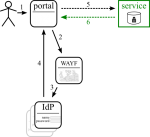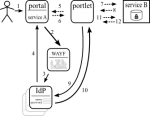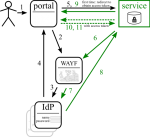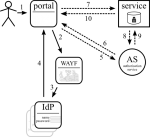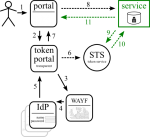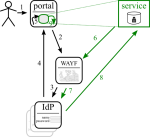Difference between revisions of "CLARIN/Security for web services"
(→Other) |
(→Other) |
||
| Line 121: | Line 121: | ||
* [http://portabilitypolicy.org/ Data portability], and [http://dataportability.org/ blog] | * [http://portabilitypolicy.org/ Data portability], and [http://dataportability.org/ blog] | ||
* OAuth 2 uses bearer tokens and misses signatures, which [http://hueniverse.com/2010/09/oauth-2-0-without-signatures-is-bad-for-the-web/ may become a problem]. | * OAuth 2 uses bearer tokens and misses signatures, which [http://hueniverse.com/2010/09/oauth-2-0-without-signatures-is-bad-for-the-web/ may become a problem]. | ||
| − | * Nice [http://davidlyness.com/post/twitter-oauth OAuth 1 | + | * Nice [http://davidlyness.com/post/twitter-oauth OAuth 1] and [http://www.independentid.com/2011/03/oauth-flows-extended.html OAuth 2] diagrams |
* [http://profsandhu.com/zhang/pub/sacmat11-xdauth.pdf xDAuth] | * [http://profsandhu.com/zhang/pub/sacmat11-xdauth.pdf xDAuth] | ||
* [http://contentdm.lib.byu.edu/ETD/image/etd2515.pdf SimpleAuth]: adaptation of OpenID to support delegation (though this might be something entirely different) | * [http://contentdm.lib.byu.edu/ETD/image/etd2515.pdf SimpleAuth]: adaptation of OpenID to support delegation (though this might be something entirely different) | ||
Revision as of 16:01, 12 May 2011
General requirements
The general delegation issue as discussed before has the following requirements.
|
for the User
|
for Services
|
for the System as a whole |
Optional or variable criteria:
- Restrictions on delegation
- Performance / overhead
(*) "Workshop security for web services - discussion minutes", W. van Engen, 2010
Specific requirements for this use-case
The practical use-case that is being looked at is a lot simpler. Here a user logged into the CMDI portal needs to be able to access private information in the ISOcat registry. This means that logging into the CMDI portal should give access to the ISOcat registry as well. How exactly, that is the topic of this discussion.
The requirements for this specific use-case are equal to the general case though a little simpler:
- Only one level of delegation is required: a single service should be accessed from the portal
- All user interaction is in the web-browser
- Delegation needs to happen only when the user is active in the portal (not offline)
Options
There are different ways of tackling the issue, but only some can survive. (In the diagrams solid lines are browser redirects, dashed lines are communication outside of the browser.)
Open
All services trust each other. No technical security measures other than requiring a user to be logged in. This could be manageable when administered by a single person. Adding a service requires some some degree of proof that it behaves well.
SAML ECP
There is a SAML Enhanced Client or Proxy (ECP) profile that supports delegation of credentials. Delegation is done directly by the identity provider, which requires support. Since people of all (European) federations need to be able to use the system, this is probably not possible.
It also appears to be required that each IdP should be configured which services can delegate to which other services. This requires too much interaction with IdP maintainers.
Shibboleth
Shibboleth is used by many IdPs. It has ECP support with delegation; Shibboleth v1.2.3+ has a plugin for this, while Shibboleth v2.2+ has this included by default. Services using this can rely on the corresponding delegated authentication integration library.
If all IdPs would have Shibboleth version v2.2 or higher this could be a very interesting option. Most of the IdPs appear to use Shibboleth 2.x and/or SimpleSAMLphp (which doesn't seem to support ECP), though some use PingFederate, PAPI, OpenAthens or possibly other products.
OAuth 1.0
OAuth 1 is used on the world wide web as a method to access server resources on behalf of a resource owner. It is used by quite a number of big websites like Google, Twitter.
OAuth 1.0 requires browser redirection. The service manages its own access tokens, each service needs an access token that originates from the user's browser (obtained via redirection). So nested service invocations are not an option. This would suffice for this specific use-case, but not in general.
OAuth 2.0
OAuth 2 is the next evolution of OAuth (still in draft), which supports many more scenario's. This is being adopted (Facebook is on the wagon already). RedIRIS has already made this work with Shibboleth in OAuth2lib. Here the AS is a token service that is populated by the portal.
WS-Trust / SAML STS
It is also possible to use SAML with an STS. This is probably much like the OAuth 2.0 scenario. More research pending... SURFnet has had an evaluation of this with respect to delegation. 1 2
Probably WS-Security is only supported with Shibboleth 2 and higher (not 1.x).
Intermediate Token Portal
Expanding on the OAuth 2.0 approach, one could decouple feeding the token service (STS, or AS in previous diagram) from the user portal: a dedicated portal (that is invisible to the user by redirects) could do this instead. This could improve security and make building portals easier.
Browser mashup
It may also be possible to keep the portal and service completely separated and combine them in the browser (the web mashup approach). As the service is in this case no more than a pick-list, it could be put in an iframe, which could somehow return a value to the parent document (some tricks required, but it may be possible). Authentication of the portal and the service is then completely unrelated, but single sign-on can make this a smooth experience.
In web terminology this is called cross-domain transport/communication, which could be implemented using an iframe, 3rd-party cookies, JSONP, referer and probably others. 1 2
This is not a general solution, but may be a simple solution for this specific case.
Moonshot
The Moonshot project is focused on also making non-web-browser-clients work with federations. A token is obtained from an identity provider (using PEAP) which is used to access the service. In this GEANT3 project there are also ideas to implement single sign-on and delegation based on Kerberos.
This requires support at the client-side, which means the user's web browser. For Firefox there is an extension, for other browsers I haven't been able to find something. This probably means that the project is in a too early stage to make use of; not necessarily its technology but field adoption.
Links
Standards
- User Managed Access (UMA) has some overlap with this work
- OASIS Web Services Security: WS-Security, username, X.509, SAML
- A SASL and GSS-API Mechanism for SAML, uses base64 encoded SAML request in URL
- ways to use SAML (and SAML interop scenarios)
- OAuth 2.0, and with SAML assertions
Libraries
- OAuth 2 assertion profile library
- Shibboleth ECP IdPdelegation, web-service client, and configuring it.
Federations
Other
- N-tier usage of SAML in backend
- Similar project in US' department of defense
- Data portability, and blog
- OAuth 2 uses bearer tokens and misses signatures, which may become a problem.
- Nice OAuth 1 and OAuth 2 diagrams
- xDAuth
- SimpleAuth: adaptation of OpenID to support delegation (though this might be something entirely different)
